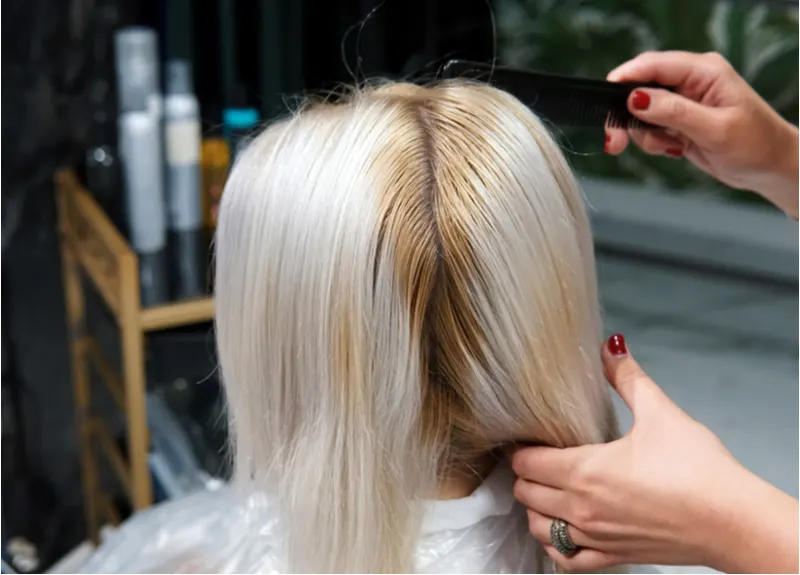Jump to:
If your last dye job turned disastrous, this guide will show you how to fix patchy hair dye in just a few simple steps. Sometimes hair dye doesn’t take quite the way it should, so keep reading to find out how to fix patchy hair dye in the comfort of your own bathroom.
Fixing Patchy Hair Dye: A Summary

Gleb_Leve/Shutterstock
If you’ve dyed your hair on your own before, you won’t have a problem taking on a patchy repair. It’ll be a bit more of a targeted job, but it’s pretty simple to do.
- Assess the Situation
- Gather Your Supplies
- Choose Your Dye
- Prep Your Hair
- Mix Your Dye
- Section Off Your Hair
- Apply the Dye
- Double Check, Rinse, and Wash
- Hair Color Aftercare
Are you ready to get going on fixing that unsightly dye job? Read over the following steps to get yourself prepared to get started.
How to Fix Patchy Hair Dye in 9 Easy Steps
You can fix your patchy hair dye in just a few simple steps. However, it’s essential you follow each of the following steps closely to ensure the best results.
1. Assess the Situation
Patchy dye jobs don’t have a one-size-fits-all solution. So, your first step is to assess the situation. A few rules of thumb:
- All-over patchiness is usually the result of poor color-mixing. If this is your issue, you’ll need to take care to thoroughly mix the color and developer when you fix the problem.
- Orange or yellow spots will require special shampoo or toner to help with the issue. However, there are specific rules you’ll have to follow that we’ll discuss below.
- Uneven roots will call for a second dye job using a new dye color.
2. Gather Your Supplies
The first step in fixing your patchy hair dye is gathering the appropriate supplies. They’re standard hair-dyeing materials, so, with the exception of a clarifying shampoo, toner, or lavender shampoo, you’ll probably have all the basics on hand already. You’ll need:
- Dye
- Towels
- Rubber gloves
- Hair clips
- Hairstyling cape
- Wide-tooth comb
- Rattail comb
- Hair color brush
- Timer
- Shampoo
- Conditioner
- Lavender shampoo, clarifying shampoo, or toner (optional)
3. Choose Your Dye
There are a few different reasons your dye job might’ve come out patchy, so you’ll need to choose your new dye based on the reason things went wrong in the first place.
Uneven Base
If you’re coloring over a patchy dye job, you’ll need to choose a color that’s two shades darker than the previous color.
Prior Incorrect Application
When you apply your dye incorrectly, you could end up with roots and lengths that don’t match. In that case, you can use the same shade you used on your initial application.
Incorrect Mixing
Incorrectly mixing your dye can easily lead to a patchy dye job. In this case, you can use the same color you used previously, but you’ll need to make sure you mix it properly this time to avoid making the problem worse.
Damaged Hair
If your hair is severely damaged, you could end up with a patchy look. If that’s the case, you can use the same color you chose initially, but you’ll have to prep your hair with conditioner and masks first for a couple of weeks.
4. Prep Your Hair
This step applies if you’re attempting to fix orange or yellow brassiness using lavender shampoo. You’ll need to wash your hair with lavender shampoo for 2-4 days before applying any dye.
In some cases, the lavender shampoo or clarifying shampoo might correct the issue on its own, which is often the case when it comes to semi-permanent dye jobs.
However, if you used a permanent dye, you’ll need to purchase a color that’s two shades darker than the original to use after you’ve applied the correcting shampoo. A second option for correcting brassiness is to apply a hair toner.
Using a toner is an excellent way to minimize the amount of dye you’ll need to add to your hair. Toner will help even out the color more, making the differences between the light and dark areas less stark. Blue or purple toner can go a long way in correcting orange and yellow tones, respectively.
Another reason for patchy hair dye is damaged hair. If your hair is damaged, you’ll need to apply a deep conditioner and hair mask to your hair. Do this for about two weeks to help your hair get back to a healthy state.
5. Mix Your Dye
If you’ve used your lavender or clarifying shampoo and are still seeing spots, you’ll need to break out a new box of dye. One of the most common reasons a dye job turns patchy is incorrectly-mixed hair dye, so you must follow the manufacturer’s instructions to a T.
So, after you read over the instructions, take time to make sure you thoroughly mix your developer and dye. You want all components to meld so they provide a smooth, even coverage on your hair that’ll cover up any patches.
6. Section Off Your Hair
Once you’ve mixed the dye, it’s time to section off your hair. You shouldn’t skip this step because sectioning off your hair goes a long way in ensuring even coverage. First, comb through your hair using a brush or your wide-tooth comb to remove any tangles.
Then, using your hair clips, section your hair into four sections, keeping the parts as straight as possible with your rattail comb. Proper sectioning will allow you to easily control how and where you apply the dye to your root areas. It will also help you avoid over or under-dyeing sections of hair, giving you nice, even coverage.
When it comes to fixing or preventing a patchy dye job, uniform coverage is of the utmost importance. This is also the best time to apply a skin protectant, such as petroleum jelly, to your hairline and ears so the hair dye doesn’t stain your skin.
Read Next: How to Remove Permanent Hair Dye From Your Skin
7. Apply the Dye
Another common reason a dye job goes spotty is due to incorrect application. Although applying your dye the same way you would use shampoo might seem like a quick and easy way to get full coverage, it can actually do exactly the opposite.
Shampoos have ingredients that cause foam, which allows the shampoo to coat every strand with little effort. Dyes, on the other hand, don’t have those foaming ingredients. Instead, hair dyes are more like paint.
So you’ll need to make sure you coat each strand for the best results. That’s why it’s crucial to use a hair color brush for the application process. You can target specific areas and get close to the scalp much easier with a brush.
Of course, you can and should use your fingers, too, but you shouldn’t rely on just your hands for this job, especially since you want to ensure you’re filling in each spotty section.
You’ll start from the bottom of your hair’s length during a standard dye job and work your way up to the roots. However, if you want your roots to be darker than the rest of your hair, which is often the case with patchy jobs, you’ll want to start at the root.
8. Double Check, Rinse, and Wash
Check all the patchy areas when your timer goes off and make sure they’ve taken the right amount of color. If you’re satisfied that you’ve covered each area thoroughly, you can rinse out and wash your hair. Start by washing just the dye out of your hair.
Then, take another look at the dyed areas to make sure you’re still happy with the coverage. Finally, apply a color-safe shampoo and conditioner to help protect the color and give your hair a boost of moisture. Then, style your hair as usual.
9. Hair Color Aftercare
Proper hair color aftercare is essential for maintaining a color change. If you don’t have a solid haircare plan, you could end up with a faded dye job or added brassiness. Fortunately, you can do a few things to keep your freshly-dyed hair looking and feeling great.
Always use a color-safe shampoo and conditioner. These will help keep your hair color looking great. You could also work in a color-depositing shampoo to help minimize the stark difference between your roots and dyed color as your hair grows.
Another way to protect your hair and hair color is by minimizing how frequently you wash and blow-dry your hair. It is especially true if you used a semi-permanent color that you want to extend the life of.
Finally, do a deep conditioning treatment 2-3 times a month to help keep your hair full and healthy. These treatments will also help reduce any severe drying that might result from dyeing your hair.
Frequently Asked Questions

Master1305/Shutterstock
Although fixing a patchy dye job is a reasonably straightforward process, you might still have a few questions. So here’s a bit more information that’ll help make the process a bit simpler:
How do I get even coverage with hair dye?
Before you toss your gloves and let your hair set, take a good look over your hair and add dye to any missed spots. This is the best way to avoid a patchy dye job.
Should I dye my roots first or last?
One way to avoid a patchy dye job is to dye your roots last. The hair closer to your scalp takes dye much easier than the length, so you’ll want the color to absorb into the lower sections of your hair longer.
What does banding mean in hair color?
When you layer dye jobs, you might see a band of color that wraps around your head where the two colors overlap. When it appears, it is referred to as banding.
How soon can I dye my hair again to fix it?
Dyeing your hair is a pretty damaging process, so you should limit how often you do it. However, if you need to fix patchiness, you should wait two weeks before red-yeing. Doing this will give the color time to set and will prevent irreversible damage.
What can I do about patchy bleached hair?
Treat patchy bleached hair the same way you would any other patchy dye job. That said, choosing a darker shade will better cover up patchiness than trying to do another bleach job.
So, How Do You Fix Patchy Hair Dye?
Fixing a patchy dye job is just as straightforward as doing your standard dye job, but it just requires a bit more care. So, following the steps here, you’ll be able to apply new dye to your hair and take care of those unsightly spots with minimal effort.
